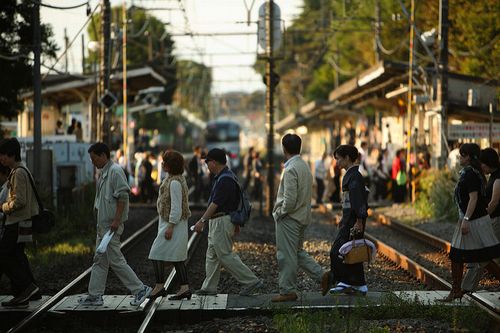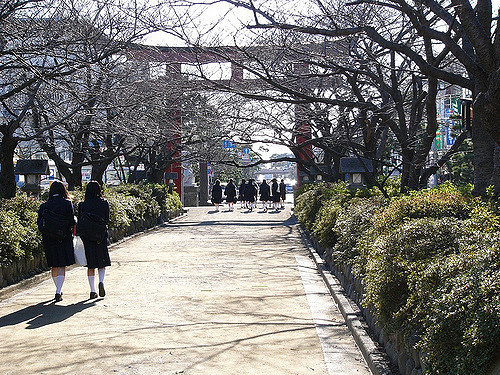September 9, 2009
Community Laws Preserve Ancient City's Landscapes
Keywords: Newsletter
The City of Kamakura, Kanagawa Prefecture
JFS Newsletter No.84 (August 2009)
"Initiatives and Achievements of Local Governments in Japan" (No. 25)

Image by mrhayata Some Rights Reserved.
Located in Kanagawa, a prefecture neighboring Tokyo, Kamakura is an ancient city that many residents in the metropolitan area have visited at least once. Within an hour by train from Tokyo Station, visitors can enjoy valuable historical treasures, a rich natural environment and different seasonal views in and around this popular sightseeing city throughout the year. Its old streetscapes and beautiful coastlines attract people, many hoping to live there. Actually, Kamakura is also a very popular residential city, as it always ranks among the top best cities in Japan to live.
Old temples standing quietly in dense woods, hills overlooking Enoshima Island and the Bay of Sagami, and Wakamiya Oji Street, which stretches straight from Yuigahama Beach to the Tsurugaoka Hachimangu Shrine; these views in Kamakura bring comfort to visitors and residents, as they almost never change. These distinctive views, however, cannot be taken for granted as having never changed for a long time. Indeed, the city has a history of being subjected to many development plans, time and again, and overcoming the crises of landscape destruction each time.
The Oyatsu Dispute and Ancient Capitals Preservation Law
Kamakura was established as the seat of the shogunate (Japan's feudal government) about 800 years ago by Yoritomo Minamoto, the first shogun (general) in the Kamakura era (1185-1333). For about 150 years, it enjoyed prosperity as the political, economic, and cultural center of Japan. The unique topography of the area -- facing the ocean on one side and surrounded by hills on three sides -- played an important role as a natural stronghold for the then-capital city. After the fall of the Kamakura shogunate government, the city became a quiet fishing and farming town. It was in the Meiji era (1868-1912) when Kamakura started to get revitalized as a beach resort site and an area of holiday homes, after the Yokosuka rail line was opened.
During Japan's rapid economic growth from 1955 to 1975, Kanagawa Prefecture experienced fast-paced urbanization as a commuter town of the Tokyo metropolitan area, and Kamakura was no exception. Forests in the city were cut to develop residential areas. Against this background, in 1964, when the entire country was excited about the Tokyo Olympic Games, the Oyatsu Forest, located behind the Tsurugaoka Hachimangu Shrine, was targeted for a housing land development. The forest has long been considered as a sacred area in this ancient city.
After learning about the plan, the local residents started a campaign against the development, claiming that the historical landscape of the Tsurugaoka Hachimangu Shrine would be damaged. The intellectuals living in Kamakura participated in this campaign, which was called the "Oyatsu Dispute," expanding the campaign to a nationwide environmental protection movement. Novelist Jiro Osaragi, one of the intellectuals, contributed greatly to the establishment of the Kamakura Trust ("Kamakura Fuchi Hozon no Kai" in Japanese), the first national trust organization in Japan. With donations from people all over the country and aid from the city government, the Kamakura Trust purchased 1.5 hectares of the Oyatsu Forest and forced the developer to drop its plan. This campaign led to the enactment of the national Act on Special Measures concerning Preservation of Traditional Scenic Beauty in Ancient Capitals, or the Ancient Capitals Preservation Law for short, in 1966.
Upon the passing of the act, a 695-hectare area and a 226.5-hectare area (out of the total 3,950 hectare-land area of Kamakura) were designated as preservation zones of traditional scenic beauty. Today, the first zone of traditional scenic beauty has been expanded to 982.2 hectares and the other to 573.6 hectares. Along with the scenic zone program introduced in 1938, this law contributed to preserving and shaping landscapes in Kamakura.
What is the Ancient Capitals Preservation Law? -- City of Kamakura
http://www.city.kamakura.kanagawa.jp/keikan/kotohozonhou.html (Japanese only)
City Planning and Development Permit Systems in Japan
The Ancient Capitals Preservation Law and the scenic zone program alone could not perfectly maintain Kamakura's landscapes. Here, we briefly describe Japan's city planning system. During the years of rapid economic growth, indiscriminate urbanization in and around major cities became a matter of public concern in Japan. This led to the introduction of a development permit system under the national City Planning Law established in 1968.
This system aims to prevent indiscriminate urbanization and ensure a decent level of residential conditions by strategically improving a city's infrastructure. The system designates certain areas as city planning areas, which are the areas that need to be developed in a comprehensive way. In city planning areas, there are urbanization areas, where strategic urbanization is promoted, and urbanization control areas where urban development is restricted, in principle. When urbanization areas are developed at certain scales, developers are required to build public facilities there; meanwhile, in urbanization control areas, land development is not allowed, in principle.
Urbanization areas are subdivided into districts according to use, such as residential, commercial, and industrial districts, and the restriction of the purposes and the scale of buildings are determined according to the type of district. Also in Kamakura, urbanization areas and urbanization control areas were designated in 1970. But at that time, pressure for land development was still high, and many green spaces were designated as urbanization areas premised on expanding urban areas. For this reason, even a large scale of development was allowed in such green spaces, on the conditions that the developments should bring about improvement of roads, sewage works, etc.
Meanwhile, although the Ancient Capitals Preservation Law prohibits the redevelopment of historic landscapes in specific preservation districts, it does not strictly restrict the development of historic landscape preservation districts, as compared to the specific preservation districts. This is because the development of the historic landscape preservation districts can be done under a notification system, rather than a permit system. In Kamakura, historic landscape preservation districts overlap the scenic zone specified by the City Planning Law, so the development of the preservation districts in urbanization areas can be permitted if the height of the building and its building-to-land ratio conform with the development permit criteria for scenic zones.
Scenic Zones in Kamakura
http://www.city.kamakura.kanagawa.jp/keikan/huutitiku.html (Japanese)
Development in the use-districts is restricted by the national regulations based on the City Planning Law and the Building Standard Law, whereas development in scenic zones is regulated based on Kanagawa Prefecture's ordinance on scenic zones. Under these rules, construction will be allowed if it satisfies certain requirements; that is, in Japan, construction works can be conducted if they meet minimal criteria. On the other hand, Kamakura has long provided administrative guidance to restrict development that has the potential to mar the landscapes of the city, such as the construction of high-rise buildings.
Kamakura's Original Rules Backed by Landscape Law
Walking along Wakamiya Oji Street, the main street of Kamakura that leads to the Tsurugaoka Hachimangu Shrine, you will feel that the sky is boundless, since there are no high-rise buildings on the street. This is one of the achievements of the city's guidance. Originally, the height of the buildings was not restricted in this district. Even buildings 30 meters or higher were allowed to be built. The building height, however, has been limited to 15 meters (equivalent to a five-story building) or lower, under the city's guidance. Likewise, while the height of buildings in scenic zones was originally limited to 15 meters or lower, it has been limited to eight meters (equivalent to a two-story building) or lower.

Image by Ryosuke Yagi Some Rights Reserved.
Administrative guidance is simply what a city wants businesses to do, however, and it does not have legally binding force. For businesses, administrative guidance represents property rights infringement. Thus, Kamakura enacted the Kamakura City Landscape Ordinance in 1995 to start working on the city's unique landscape planning, while enacting the Kamakura City Development Ordinance in 1995 and the Ordinance regarding the Procedures and Standards of Kamakura City Development Projects in 2002 to establish the system supported by ordinances.
Meanwhile, the Japanese government established the Landscape Law in 2004, which began to support local governments struggling with landscape-related problems. Thanks to the new law, local governments were able to incorporate landscape rules tailored to their regional characteristics into their landscape plans to regulate and guide construction. Furthermore, local governments were also empowered to set these rules as ordinances to use them as criteria for granting development permits. The rules unique to Kamakura eventually became supported by the national law.
Kamakura, which gained the status of "landscape administrative organization" in May 2005 after the Landscape Law entered into force, designated the entire city as a landscape planning area. Each district of Kamakura has its own unique landscapes, such as historic sites, residential areas spreading in the hills, and commercial areas along the coast. Thus, in the landscape plan, the city classified the entire city into 21 types according to land use, and defined the policy and standards of landscape creation for each area. For example, a detailed policy was established for traditional residential areas, such that landscapes harmonized with mountains in the back should be maintained, and planting should be done along fences.
The city also designated an urban area around Wakamiya Oji Street as a scenic district, where the city promotes landscape creation more actively than other areas. In this district, buildings are restricted to 15 meters in height, and any designs including colors should follow certain standards. For example, the Starbucks Coffee Onari Cafe in front of Kamakura City Hall has a Japanese-style construction with subdued colors that match the Kamakura landscape.
Introducing the Samurai Spirit to the World
After Japan entered the age of high economic growth, unique landscapes around Japan changed dramatically due to Japan's policy to prioritize economic development. Construction of office and residential buildings was allowed without restrictions, and thus development in many areas of Japan became disorderly and places lost their regional characteristics. Even in those days, Kamakura continued to protect its traditional landscapes by setting local rules. Considerable efforts must have been made by the citizens and administrative organizations of Kamakura to do this.
Kamakura is now preparing to be designated as a World Heritage site as an ancient capital of the samurai. It may be the spirit of the samurai handed down over hundreds of years in Kamakura that has created the city's firm resolve when it comes to the land. As a result, many visitors from around the world are deeply impressed with the spiritual and cultural heritage preserved in the city.
Written by Ichie Tsunoda
Related
"JFS Newsletter"
- 'Good Companies in Japan' (Article No.4): 'Eightfold Satisfaction' Management for Everyone's Happiness
- "Nai-Mono-Wa-Nai": Ama Town's Concept of Sufficiency and Message to the World
- 'Yumekaze' Wind Turbine Project Connects Metro Consumers and Regional Producers: Seikatsu Club Consumers' Co-operative
- Shaping Japan's Energy toward 2050 Participating in the Round Table for Studying Energy Situations
- 'Good Companies in Japan' (Article No.3): Seeking Ways to Develop Societal Contribution along with Core Businesses


